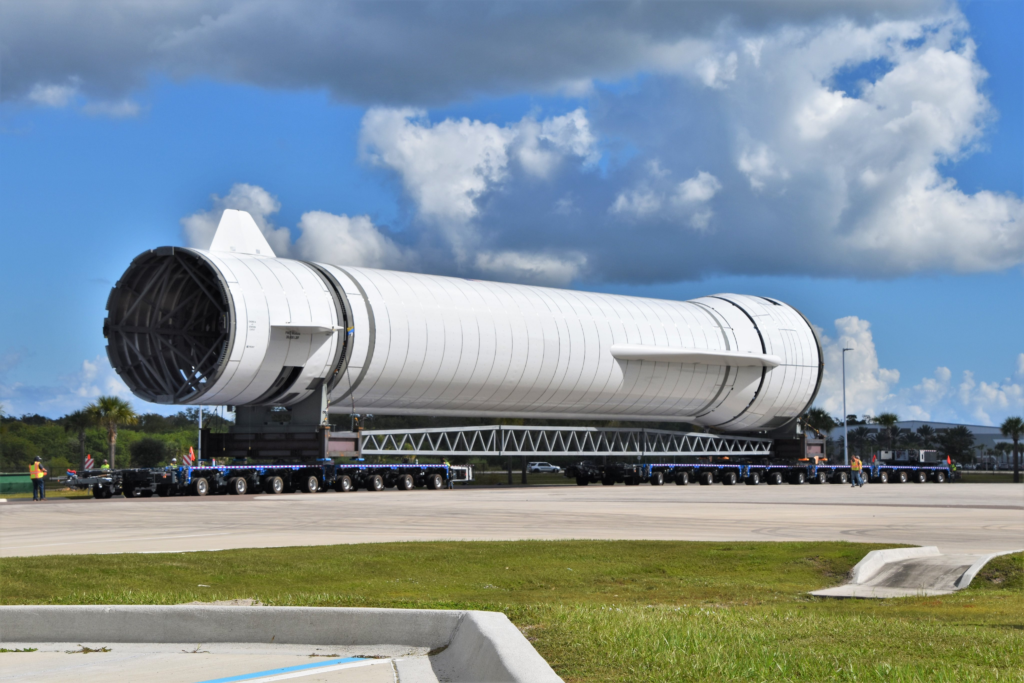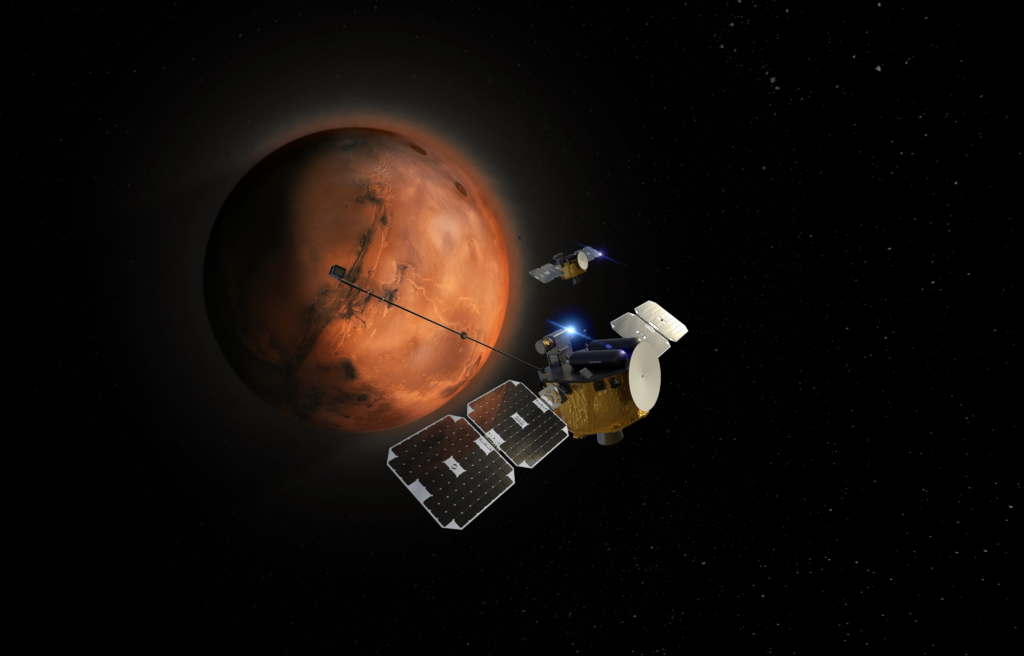
Blue Origin’s New Glenn Was Just Awarded A 2024 Mars Launch Contract
Blue Origin is not known for being very public when it comes to big projects such as New Glenn. In reality, practically all the progress being made happens behind closed doors which makes it hard to keep up with the project and its future timeline. All this being said, NASA just awarded the next-generation launch vehicle a significant contract that might hint at the company’s progress.
Only two days ago, both NASA and Blue Origin revealed that the company will now launch the agency’s ESCAPADE mission to Mars as part of the VADR launch services contract. Specifically, this mission will utilize New Glenn to launch two Rocket Lab Photon spacecraft to the Martian planet. Most interestingly, this mission is scheduled to happen in late 2024.
This is an extremely ambitious time frame for New Glenn which from what we’ve seen still has a lot of development and testing necessary before an actual launch. Not to mention the fact that if this date was missed, the next opportunity would be years later toward the end of 2026, putting more pressure on the company. Here I will go more in-depth into this new launch contract, what it means for Blue Origin and New Glenn, what to expect in the future, and more.
Mars Launch Contract

Only two days ago on the 9th, Blue Origin tweeted saying, “We’re honored to have been selected by @NASA_LSP to launch the ESCAPADE science mission on #NewGlenn. With ESCAPADE, NASA will study Mars’ magnetosphere.” Specifically, ESCAPADE will launch on Blue Origin’s New Glenn rocket from Space Launch Complex-36 at Cape Canaveral Space Force Station in Florida. The launch is targeted for late 2024. Blue Origin is one of 13 companies NASA selected for VADR contracts in 2022. As part of VADR, the fixed-price indefinite-delivery/indefinite-quantity contracts have a five-year ordering period with a maximum total value of $300 million across all contracts.
The VADR missions are intended to be somewhat higher risk. In a quote NASA points out, “These small satellites and Class D payloads tolerate relatively high risk and serve as an ideal platform for technical and architecture innovation, contributing to NASA’s science research and technology development.
It will take ESCAPADE about 11 months to arrive at Mars after leaving Earth’s orbit, where both spacecraft will spend several months adjusting their orbits before they are in a position to best capture data about the magnetosphere. Studying different magnetospheres gives scientists a better understanding of space weather, which can protect astronauts and satellites both as they orbit Earth and explore the solar system. What’s even more interesting is the fact that Rocket Lab is responsible for the two Photon spacecraft making the long journey.
Back in 2021, Rocket Lab began its final mission design and commenced manufacturing of two interplanetary Photon spacecraft for a science mission to Mars, delivering Decadal-class science at a fraction of the cost of typical planetary missions. Up until only days ago, the mission was set to happen aboard a NASA-provided commercial launch vehicle. We now know that New Glenn is that vehicle.
However, the late 2024 launch date brings up a lot of questions. As partially mentioned before, because this is a mars mission, if the launch date is missed, the next opportunity will be around two years later in late 2026. This has to do with ensuring Earth and Mars are aligned in a way that minimizes travel times and expenses. Ideally, this would not be the case but VADR missions are higher risk so it could happen. The other possibility is that NASA genuinely believes Blue Origin will be capable of a mission to Mars with New Glenn in less than two years from now. Using the information we have access to, this seems extremely unlikely due to the amount of testing and development necessary prior. On the other hand, NASA has access to a lot more behind the scenes information and could be confident based on what they have seen that New Glenn is actually making very fast progress.
New Glenn’s Progress

Now that we know more about New Glenn’s upcoming mission, we can take a closer look at what actual progress the rocket is making and whether or not this launch date is realistic. In the last couple of months, a lot of Blue Origin’s focus has been on the BE-4 engine. Due to the partnership with ULA, the company is responsible for manufacturing enough engines to support both Vulcan and New Glenn. This is quite the task but something that Blue Origin is trying to ramp up. Back in October, Blue Origin completed its delivery of the first BE-4 shipset for United Launch Alliance (ULA), shipping the engines to ULA’s factory in Decatur, AL after final acceptance testing.
Around this time they also reported that dozens of these engines are now in production to support a large and growing demand for civil, commercial, and defense launches. This being said, developing, producing, and testing a next generation rocket engine is an immensely complex process. Combine this with the demand and Blue Origin has its plate full with just this one primary New Glenn component. Thankfully for the New Glenn program, two of these engines are only weeks away from their most important test yet.
A few days ago ULA CEO Tory Bruno tweeted mentioning, ” I thought you guys might enjoy a #ToryTimelapse from stacking the Amazing Centaur V last week on top of the #VulcanRocket Booster.” By now Vulcan is fully stacked and getting ready for final testing. Here they will static fire the two BE-4 flight engines for the first time while being integrated on the launch vehicle. Assuming they work perfectly and the test results are promising, a launch in March is very realistic. In this case, if the launch is successful, Blue Origin will receive a host of invaluable flight data relating to these engines and have the confidence to ramp up production of the engine. On the other hand, if something were to go wrong relating to the BE-4, it would completely halt engine development as they find out exactly what went wrong. This would be the worst case scenario and delay New Glenn by a long shot.
Currently, Blue Origin as a company is targeting the first launch of New Glenn for 2024, however, a more realistic timeframe would be closer to mid to late 2025. While progress is being made, there is so much work to be done which will take time. New Glenn is also a very ambitious rocket that is both very powerful and partially reusable. The jump from New Shepard to New Glenn for example helps put into perspective the work and new challenges the company is facing. Specifically, New Glenn’s fully reusable first stage is designed for a minimum of 25 flights.
In order to make this possible, the BE-4 engine was built with reusability in mind. BE-4 was designed from the beginning to be a medium-performing version of a high-performance architecture. This design choice was made to lower development risk while attempting to meet performance, schedule, and reusability requirements. It uses LNG because its highly efficient, low cost, and widely available. Unlike kerosene, LNG can be used to self-pressurize its tank. Known as autogenous repressurization, this eliminates the need for costly and complex systems that draw on Earth’s helium reserves. LNG also possesses clean combustion characteristics even at low throttle, simplifying engine reuse compared to kerosene fuels.
The New Glenn primary booster is an operationally reusable first stage with a length of 57.5 m (188.5 ft) and a tank diameter of 7 m (23 ft). The stage consists of three sections: aft, mid, and forward. The aft module contains the 7 BE-4 engines. The mid module of the booster houses the fuel (LNG) and oxidizer (LOX) tanks. The tanks are made of orthogrid aluminum and are designed to withstand the high g-loads realized during reentry. Large aerodynamic strakes on the aft end of the tanks give the returning first stage enhanced cross-range during descent and reentry. Lastly, the forward module of the booster features four actuated aerodynamic control fins for attitude control during descent. This section of the booster also provides ground umbilical connections for New Glenn and interstage housing of the two second stage vacuum-optimized BE-3U engines.
The second stage is an expendable LOX/LH2 stage with dual gimballing BE-3U engines with 1,060 kN (240,000 lbf) total thrust in vacuum. The stage also has a tank diameter of 7 m (23 ft) and uses common tooling with the first stage to reduce recurring cost. The length of the second stage tank is 16.1 m (52.9 ft) and the overall length including the two high expansion ratio nozzle BE-3Us is 23.4 m (76.9 ft). Similar to the first stage, the second stage has aft, mid, and forward sections. After second stage separation, the first stage booster reorients itself to reenter the atmosphere aft end first. Through a combination of aerodynamics and propulsive maneuvers, the stage performs a precision landing on the ocean-going platform in the Atlantic Ocean. After initial plans to use a large converted cargo ship, Blue Origin has now contracted the same company as SpaceX did to create a large drone ship to land New Glenn’s booster and bring it back to land.
Conclusion
Blue Origin has been working on New Glenn for years now, primarily behind the scenes. Just two days ago, we learned that the company was awarded a mission to Mars scheduled less than two years away. This is quite a big deal due to the timeframe and the fact that Blue Origin could be further ahead than they let on. We will have to wait and see how it progresses and the impact it has on the space industry.
